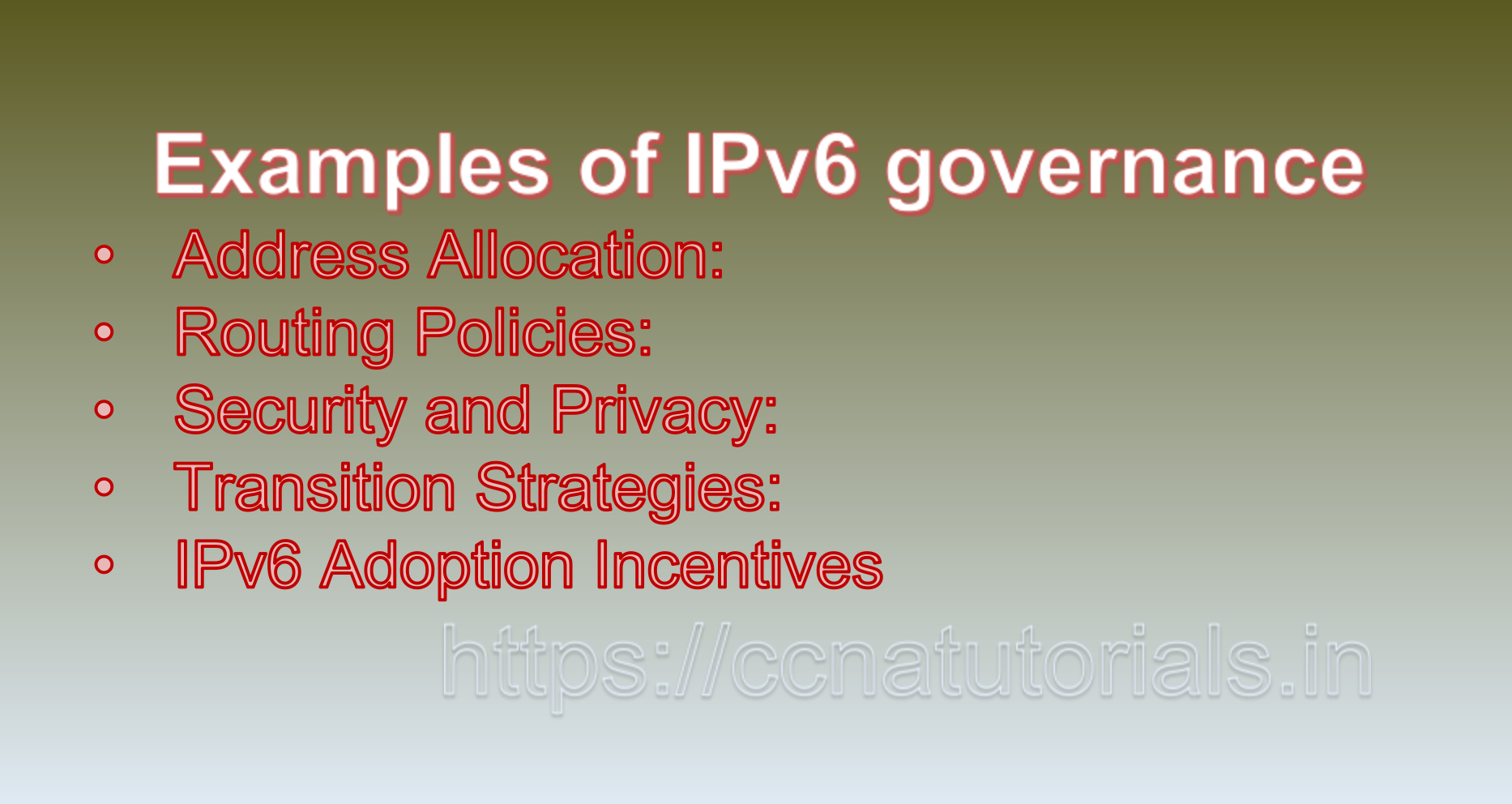Contents of this article
In this article, I describe IPv6 Governance and Policy and related terms. IPv6 (Internet Protocol version 6) governance and policy refer to the rules, regulations, and management practices that guide the allocation, distribution, and usage of IPv6 addresses and resources on the Internet. The IPv6 is the latest version of the Internet Protocol, designed to address the limitations of IPv4, which is running out of available addresses. IPv6 introduces a significantly larger address space, enabling the continued growth of the Internet.
IPv6 Governance and Policy in the context of IPv6 involve various entities, including regional Internet registries (RIRs), national governments, Internet service providers (ISPs), and other stakeholders. These entities work together to define rules and guidelines for the fair and efficient distribution and management of IPv6 addresses. Here are some key aspects of IPv6 governance and policy, along with examples:
1. Address Allocation:
RIRs are responsible for allocating IPv6 address blocks to ISPs, organizations, and entities within their respective regions. IPv6 address allocations are typically made based on demonstrated need. For example, an ISP planning to offer IPv6 services to its customers would need to justify the number of addresses it requests based on the number of subscribers it serves.
2. IPv6 Adoption Incentives:
National governments and regulatory bodies may develop policies to encourage IPv6 adoption within their countries. These policies could include incentives such as tax breaks or grants for organizations that transition to IPv6. For instance, a government might offer financial incentives to ISPs that actively migrate their networks and services to IPv6 to expedite the overall adoption process.
3. Routing and Peering Policies:
Internet Exchange Points (IXPs) and network operators may establish policies for IPv6 routing and peering arrangements. These policies ensure efficient and reliable communication between different networks. For example, a peering agreement could outline the technical and administrative requirements for networks to interconnect using IPv6, enhancing network performance and reducing latency.
4. IPv6 Security and Privacy Guidelines:
Governance and policy efforts also cover security and privacy considerations related to IPv6. Organizations and policymakers may collaborate to establish best practices for securing IPv6 networks and ensuring the privacy of users’ data. This could involve guidelines on implementing secure IPv6 configurations, encryption, and intrusion detection systems.
5. Transition Mechanisms:
As the transition from IPv4 to IPv6 occurs, various transition mechanisms are used to ensure compatibility between the two protocols. Governance bodies and standardization organizations might provide recommendations on the deployment of these mechanisms. For example, they could suggest strategies for enabling communication between IPv4-only and IPv6-only networks using technologies like NAT64 (Network Address Translation 64) and DNS64.
6. Address Management Policies:
Organizations receiving IPv6 address allocations are often required to adhere to address management policies. These policies may stipulate how addresses are assigned within the organization, how changes to address assignments are documented, and how unused addresses are returned to the address pool when no longer needed.
In short IPv6 Governance and Policy
IPv6 governance and policy involve a range of stakeholders working together to ensure the efficient, secure, and equitable use of IPv6 addresses and resources. These policies cover areas such as address allocation, security, routing, and transition mechanisms, with the aim of facilitating the continued growth and stability of the Internet as it migrates to the IPv6 protocol.
IPv6 (Internet Protocol version 6) governance and policy refer to the rules, regulations, and guidelines established by various entities to manage and control the allocation, deployment, and usage of IPv6 addresses on the internet. The IPv6 is the latest version of the Internet Protocol, designed to address the limitations of the previous version, IPv4, which is running out of available addresses due to the rapid growth of internet-connected devices.
IPv6 governance and policy involve multiple stakeholders, including government bodies, regional internet registries (RIRs), internet service providers (ISPs), businesses, and technical organizations. These policies are essential to ensure the efficient and fair distribution of IPv6 addresses, promote security, and facilitate the smooth functioning of the internet as it transitions to IPv6.

Examples of IPv6 governance and policy aspects include:
1. Address Allocation:
Regional Internet Registries, such as ARIN (North America), RIPE NCC (Europe), APNIC (Asia-Pacific), and others, manage the allocation of IPv6 address blocks to ISPs and organizations within their respective regions. Policies dictate how these allocations are made, based on factors like the organization’s size, network infrastructure, and intended usage.
2. Routing Policies:
Internet Service Providers and network operators establish routing policies to manage the flow of IPv6 traffic across the internet. These policies impact how data is routed between networks, ensuring efficient data transmission and preventing routing loops.
3. Security and Privacy:
IPv6 introduces new security considerations, and policies are formulated to address potential vulnerabilities. This includes ensuring that firewalls, intrusion detection systems, and other security mechanisms are IPv6-ready.
4. Transition Strategies:
As the transition from IPv4 to IPv6 is not instantaneous, organizations need policies to manage both protocols during the transition period. This might involve dual-stack deployment (supporting both IPv4 and IPv6 simultaneously) and mechanisms like NAT64 (Network Address Translation) to facilitate communication between IPv4 and IPv6 devices.
5. IPv6 Adoption Incentives:
Governments and regulatory bodies may develop incentives to encourage organizations to adopt IPv6. This could include tax breaks, grants, or other benefits to organizations that demonstrate successful IPv6 integration.
6. Internet Exchange Points (IXPs):
Policies for IXPs, where multiple networks interconnect to exchange traffic, may include guidelines for supporting IPv6 traffic exchange, promoting better connectivity across networks.
7. End-user Allocation Policies:
ISPs and organizations might have policies for allocating IPv6 addresses to end-users or devices. This could involve considerations such as the number of devices allowed per user and the specific address assignment mechanisms.
8. Multihoming Policies:
Organizations that connect to multiple ISPs for redundancy and load balancing may require policies for managing their IPv6 address assignments across these multiple connections.
Conclusion for IPv6 Governance and Policy
Overall, IPv6 governance and policy are crucial to ensure the orderly growth and functioning of the internet as it transitions to a larger address space with IPv6. These policies help manage resources, security, and technical challenges associated with this transition. I hope you found this article helpful. you may drop a comment below or contact us for any query related to this article.






